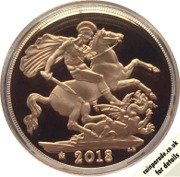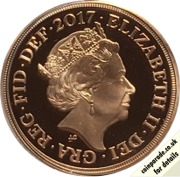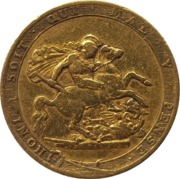
 In the UK, before a coin may become legal tender it has to follow the Coinage Act 1971. What this means is that new coins have to be approved by the State before going into production. The UK government advices and the Queen must give her approval for this to happen by issuing a Royal Proclamation.
In the UK, before a coin may become legal tender it has to follow the Coinage Act 1971. What this means is that new coins have to be approved by the State before going into production. The UK government advices and the Queen must give her approval for this to happen by issuing a Royal Proclamation. In May 2017, The Gazette published a Proclamation regarding a new coin which surprised many coin collectors: a Piedfort Gold Sovereign.
Piedfort coins are well known to Silver coin collectors. Piedforts are struck with the same die so look like normal coins but are TWICE as thick and therefore twice the weight. A first for the UK - a double thickness gold sovereign.
 The word Piedfort is derived from the French meaning ‘heavy measure’ or ‘heavy foot’. As French it should be pronounced ‘Pee-ay-fore‘ but you’ll find most UK collectors and dealers pronouncing it phonetically
The word Piedfort is derived from the French meaning ‘heavy measure’ or ‘heavy foot’. As French it should be pronounced ‘Pee-ay-fore‘ but you’ll find most UK collectors and dealers pronouncing it phoneticallyThe reason for this new coin was said to celebrate 200 years of the 'modern' sovereign. It took the same reverse design as the 1817 sovereign (shown below, right) which was designed by Benedetto Pistrucci (1783-1855).
Except for the double thickness and double weight, this coin looks like a normal sovereign. When housed in a plastic coin capsule it is actually difficult to tell the difference.
The obverse is the portrait of Queen Elizabeth II by Jody Clark and the reverse shows Pistrucci's famous George and the Dragon inside a garter border. The edge is milled.
 The mintage was limited to 3,750 with 3,500 of these being issued in special edition packaging. The Royal Mint made these available around July 2017 and offered at £800 they sold out very quickly and the street price doubled within days.
The mintage was limited to 3,750 with 3,500 of these being issued in special edition packaging. The Royal Mint made these available around July 2017 and offered at £800 they sold out very quickly and the street price doubled within days.The image to the right is the reverse of the 1817 George III Gold Sovereign, the first of the 'modern' sovereigns. (Public Domain images, Image Attribution: Classical Numismatic Group, Inc. http://www.cngcoins.com).
Piedfort Coins in General
The practice of making extra thickness coins is actually quite old, going back to the middle ages. Originally it was a French fashion that monarchs gave extra thick coins as gifts as a show of wealth, but in England we used them differently. At that time coins were minted at various locations around the country so when a new design was released the original engraver had to send out master samples (known as patterns) of the new coin to each of the regional mints. These patterns were made extra thick so not as to be confused with the actual circulation coins. The last Piedfort made for this reason was the 1588 sixpence.
Thick coins have been seen in other countries, usually minted for prestige purposes. There were very few English examples until 1982 when the Royal Mint made a 20p coin for public availability. This must have proved a success as the Royal Mint has issued Piedfort coins regularly since then.
Piedfort coins generally copy the usual circulation coins – they use the same dies – but are usually silver proof. Gold and Platinum make rarer appearances. The coins therefore have an appeal to not only collectors but also to investors who appreciate the extra weight of precious metal.
